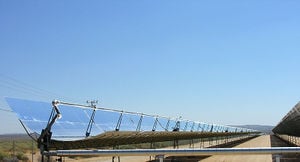
Solar thermal energy (STE)[1] is a technology for harnessing solar energy for thermal energy (heat).
Solar thermal collectors are classified by the USA Energy Information Administration as low-, medium-, or high-temperature collectors. Low temperature collectors are flat plates generally used to heat swimming pools. Medium-temperature collectors are also usually flat plates but are used for heating water or air for residential and commercial use. High temperature collectors concentrate sunlight using mirrors or lenses and are generally used for electric power production. STE is different from photovoltaics, which convert solar energy directly into electricity. While only 600 megawatts of solar thermal power is up and running worldwide in October 2009 according to Dr David Mills of Ausra, another 400 megawatts is under construction and there are 14,000 megawatts of the more serious concentrating solar thermal (CST) projects being developed.[2]
Introduction[edit | edit source]
The sun is the source of the vast majority of the energy we use on earth. Most of the energy we use has undergone various transformations before it is finally utilized. It is also possible to capture and concentrate this source of solar energy as it arrives on the earth's surface, and use the heat this concentration produces. This heat can be used directly, or used to fuel generators and produce electricity.
There are many applications for the direct use of solar thermal energy, space heating and cooling, water heating, crop drying and solar cooking. It is a technology which is well understood and widely used in many countries throughout the world. Most solar thermal technologies have been in existence in one form or another for centuries and have a well-established manufacturing base in most sun-rich developed countries.
The most common use for solar thermal technology is in domestic solar hot water. Hundreds of thousands of domestic hot water systems are in use throughout the world, especially in areas such as the Mediterranean and Australia where there is high solar insolation (the total energy per unit area received from the sun). As world oil prices vary, it is a technology which is rapidly gaining acceptance as an energy saving measure in both domestic and commercial water heating applications. Presently, domestic water heaters are usually only found amongst wealthier sections of the community in developing countries.
Other technologies exist which take advantage of the free energy provided by the sun. Water heating technologies are usually referred to as active solar technologies, whereas other technologies, such as space heating or cooling, which passively absorb the energy of the sun and have no moving components, are referred to as passive solar technologies.
More sophisticated solar technologies exist for providing power for electricity generation. We will look at these briefly later in this fact sheet.
Technical[edit | edit source]
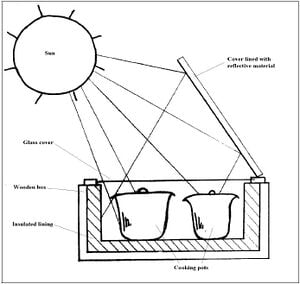
The nature and availability of solar radiation[edit | edit source]
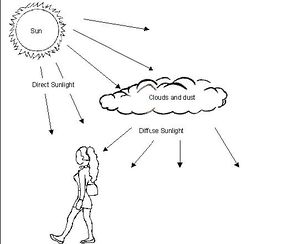
Solar radiation arrives on the surface of the earth at a maximum power density of approximately 1 kilowatt per metre squared (kW/m2). The actual usable radiation component varies depending on geographical location, cloud cover, hours of sunlight each day, etc. In reality, the solar flux density (same as power density) varies between 250 and 2500 kilowatt hours per metre squared per year (kWh/m2 per year). As might be expected the total solar radiation is highest at the equator, especially in sunny, desert areas. Solar radiation arrives at the earth's outer atmosphere in the form of a direct beam. This light is then partially scattered by cloud, smog, dust or other atmospheric phenomenon (see Figure 1 below). We therefore receive solar radiation either as direct radiation or scattered or diffuse radiation, the ratio depending on the atmospheric conditions. Both direct and diffuse components of radiation are useful, the only distinction between the two being that diffuse radiation cannot be concentrated for use.
Solar radiation arriving from the sun reaches the earth's surface as short wave radiation. The majority of the energy arriving from the sun is re-radiated into space. Some solar energy is captured through process such as photosynthesis where heat energy is transferred to chemical energy. The heat that is radiated away from the earth losses some of its energy when it interacts with an reflective surface and thus leaves the atmosphere in the form of long-wave radiation. Utilizing a solar energy source involves capturing the short wave radiation and preventing it from being re-radiated directly to the atmosphere. Glass and other selective surfaces are used to achieve this. Glass has the ability to allow the passage of short wave radiation and preventing heat from being radiated in the form of long wave radiation. This trapped heat can be stored in liquids or solids with a high thermal mass. In a water heating system this will be the fluid that runs through the collector, whereas in a building the walls will act as the thermal mass.
The geometry of the earth and sun[edit | edit source]
The earth revolves around the sun with its axis tilted at an angle of 23.5 degrees. It is this tilt that gives rise to the seasons. The strength of solar flux density is dependent upon the angle at which it strikes the earth's surface, and so, as this angle changes during the yearly cycle, so the solar insolation changes. Thus, in northern countries, in the depths of winter, where the sun is low in the sky to the south, the radiation strikes the earth's surface obliquely and solar gain (solar yield) is low.
If this energy is being used to heat water by means of a collector panel, then the tilt and orientation of this panel is critical to the level of solar gain and hence the increase in temperature of the water. The collector surface should be orientated toward the sun as much as is possible. Most solar water-heating collectors are fixed permanently to roofs of buildings and therefore cannot be adjusted. More sophisticated systems for power generation use tracking devices to follow the sun through the sky during the day.
Tracking devices that use bimetallic strips or coils do not seem to have been described in the context of appropriate technology. Bimetallic elements change shape in response to temperature changes and they can exert considerable force. Prices are low because of the wide range of applications in mass-produced products, and there is also scope for recovering elements from, for example, broken vehicle starter clutches. A commercial link that may serve to indicate costs and possibilities is Wuhu Boton Automobile Parts Factory.
There are many methods available for aiding system design and for predicting the performance of a system. The variability of the solar resource is such that any accurate prediction lends itself only to complex analytical techniques. Simpler techniques are available for more rudimentary analysis. These techniques can be found in the relevant texts.
Solar thermal energy applications[edit | edit source]
Water heating[edit | edit source]
Low temperature (below 100ºC) water heating is required in most countries of the world for both domestic and commercial use. There are a wide variety of solar water heaters available. The simplest is a piece of black plastic pipe, filled with water, and laid in the sun for the water to heat up. Simple solar water heaters usually comprise a series of pipes that are painted black, sitting inside an insulated box fronted with a glass panel. This is known as a solar collector. The fluid to be heated passes through the collector and into a tank for storage. The fluid can be cycled through the tank several times to raise the heat of the fluid to the required temperature. There are two common simple configurations for such a system and they are outlined below.
- The thermosyphon system makes use of the natural tendency of hot water to rise above cold water. The tank in such a system is always placed above the top of the collector and as water is heated in the collector it rises and is replaced by cold water from the bottom of the tank. This cycle will continue until the temperature of the water in the tank is equal to that of the panel. A one-way valve is usually fitted in the system to prevent the reverse occurring at night when the temperature drops. As hot water is drawn off for use, fresh cold water is fed into the system from the mains. As most solar collectors are fitted on the roofs of houses, this system is not always convenient, as it is difficult to site the tank above the collector, in which case the system will need a pump to circulate the water.
- Pumped solar water heaters use a pumping device to drive the water through the collector. The advantage of this system is that the storage tank can be sited below the collector. The disadvantage of course is that electricity is required to drive the pump. Often the fluid circulating in the collector will be treated with an anti-corrosive and /or anti-freeze chemical. In this case, a heat exchanger is required to transfer the heat to the consumers hot water supply.
Integrated systems combine the function of tank and collector to reduce cost and size.
Collector technology has in recent years made great advances. State-of-the-art collectors are manufactured from a variety of modern materials and are designed for optimal efficiency. Evacuated tube collectors have the heat absorbing element placed within an evacuated glass sheath to minimise losses. System complexity also varies depending on use.
For commercial applications, banks of collectors are used to provide larger quantities of hot water as required. Many such systems are in use at hospitals in developing countries.
See also Solar thermal panels.
Solar thermal electricity[edit | edit source]
Thermal energy (heat) from the sun can be used to produce electricity. Concentrated solar power (CSP) uses thermal energy from the sun to heat a liquid until it becomes steam, which is then used to generate electricity by spinning a turbine generator. There are different types of concentrated solar thermal power plants but they all use reflectors (mirrors) to capture and focus sunlight onto a receiver. The high amount of thermal energy reaching the receiver is used to generate steam to spin a turbine and produce electricity.
Types of concentrated solar thermal power plants include Solar power towers, solar dish/engines, and linear concentrating systems.[3]
Solar power towers[edit | edit source]
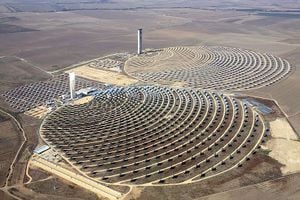
Mirrors that can turn and tilt, called heliostats, are used to concentrate sunlight onto a target, the thermal heat receiver, at the top of a tower. Heliostats move with the sun throughout the day in order to have the best angle to reflect and concentrate the sunlight onto the receiver and can have a curved shape. The more heliostats there are and the more area they take up results in a larger amount of solar energy concentrated onto the receiver.The arrangement of heliostats may vary between crescent shaped or radial arrays depending on how many receivers there are on a tower and where they are located.[4]
The concentrated thermal energy is used to melt salt. Molten salt, at temperatures on nearly 300°C, travels through pipes which go through water. The water turns into steam and spins turbines in electrical generators. Molten salt continues to store heat even after the sun goes down, providing a larger time frame for electrical generation.
Solar dish engines[edit | edit source]
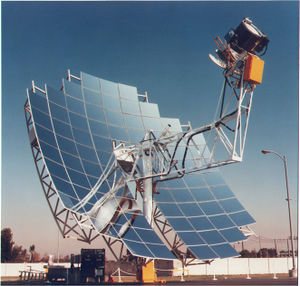
Solar dish engines use smaller mirrors to form the shape of a parabolic dish or bowl to concentrate sunlight onto a receiver to generate electricity. The dishes are programed to track the sun throughout the day in order to always capture and concentrate the most amount of solar energy possible.
The most common receiver for a solar dish/engine is the Stirling engine. The Stirling engine uses concentrated thermal energy to heat fluid to move pistons to run a generator or alternator. Engines contain hydrogen gas that expands and condenses as it heats and cools. The change in pressure drives a piston to run a generator to produce electricity.[5]
The power output range varies in relation to size but solar dish engines produce less electricity than other Concentrated Solar Power technologies.[6] Having several dishes in the same area are able to generate a larger amount of electricity.
Linear concentrating systems[edit | edit source]

Linear concentrating systems include parabolic troughs and Fresnel reflectors.
Parabolic troughs consist of long crescent shaped mirrors that have a pipe at the focus of the parabola. The pipe contains a heat transfer fluid used to produce steam to spin a turbine generator. The mirrors in parabolic troughs are able to tilt to track and better concentrate the sun throughout the day.
Linear Fresnel reflectors (LFR) are another type of linear concentrating system. LFR systems use long flat mirrors to concentrate sunlight onto an above receiver containing a heat transfer fluid used to produce steam to spin a turbine generator.
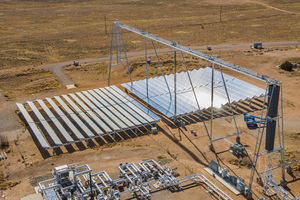
See also:
- Understanding solar concentrators
- Baseload power
- Wikipedia:Thermal energy storage#Molten salt technology
Solar cooking[edit | edit source]

Solar cooking is a technology which has been given a lot of attention in recent years in developing countries. The basic design is that of a box with a glass cover (see Figure 2). The box is lined with insulation and a reflective surface is applied to concentrate the heat onto the pots. The pots can be painted black to help with heat absorption. The solar radiation raises the temperature sufficiently to boil the contents in the pots. Cooking time is often a lot slower than conventional cooking stoves but there is no fuel cost.
Many variations have been developed on this theme but the main restriction has been one of reducing costs sufficiently to permit widespread dissemination. The cooker also has limitations in terms of only being effective during hours of strong sunlight. Another cooking stove is usually required for the periods when there is cloud or during the morning and evening hours. There have been large, subsidised solar cooking stove dissemination programmes in India, Pakistan and China.
Storage of solar engergy can also be possible. One way of doing this is via sand batteries. https://wastefree23.org/shack-a-sustainable-solution-for-community-cooking/ has an idea to do this via a hybrid system.
Crop drying[edit | edit source]
Controlled drying is required for various crops and products, such as grain, coffee, tobacco, fruits vegetables and fish. Their quality can be enhanced if the drying is properly carried out. Solar thermal technology can be used to assist with the drying of such products. The main principle of operation is to raise the heat of the product, which is usually held within a compartment or box, while at the same time passing air through the compartment to remove moisture. The flow of air is often promoted using the 'stack' effect which takes advantage of the fact that hot air rises and can therefore be drawn upwards through a chimney, while drawing in cooler air from below. Alternatively a fan can be used. The size and shape of the compartment varies depending on the product and the scale of the drying system. Large systems can use large barns while smaller systems may have a few trays in a small wooden housing.
Solar crop drying technologies can help reduce environmental degradation caused by the use of fuel wood or fossil fuels for crop drying and can also help to reduce the costs associated with these fuels and hence the cost of the product. Helping to improve and protect crops also has beneficial effects on health and nutrition.
Space heating[edit | edit source]
In colder areas of the world (including high altitude areas within the tropics) space heating is often required during the winter months. Vast quantities of energy can be used to achieve this. If buildings are carefully designed to take full advantage of the solar insolation which they receive then much of the heating requirement can be met by solar gain alone. By incorporating certain simple design principles a new dwelling can be made to be fuel efficient and comfortable for habitation. The bulk of these technologies are architecture based and passive in nature. The use of building materials with a high thermal mass (which stores heat), good insulation and large glazed areas can increase a buildings capacity to capture and store heat from the sun. Many technologies exist to assist with diurnal heating needs but seasonal storage is more difficult and costly.
For passive solar design to be effective certain guidelines should be followed:
- a building should have large areas of glazing facing the sun to maximise solar gain
- features should be included to regulate heat intake to prevent the building from overheating
- a building should be of sufficient mass to allow heat storage for the required period
- contain features which promote the even distribution of heat throughout the building
One example of a simple passive space heating technology is the Trombe wall. A massive black painted wall has a double glazed skin to prevent captured heat from escaping. The wall is vented to allow the warm air to enter the room at high level and cool air to enter the cavity between the wall and the glazing. Heat stored during the wall during the day is radiated into the room during the night. This type of technology is useful in areas where the nights are cold but the days are warm and sunny.
Space cooling[edit | edit source]
The majority of the worlds developing countries, however, lie within the tropics and have little need of space heating. There is a demand, however, for space cooling. The majority of the worlds warm-climate cultures have again developed traditional, simple, elegant techniques for cooling their dwellings, often using effects promoted by passive solar phenomenon.
There are many methods for minimising heat gain. These include siting a building in shade or near water, using vegetation or landscaping to direct wind into the building, good town planning to optimise the prevailing wind and available shade. Buildings can be designed for a given climate - domed roofs and thermally massive structures in hot arid climates, shuttered and shaded windows to prevent heat gain, open structure bamboo housing in warm, humid areas. In some countries dwellings are constructed underground and take advantage of the relatively low and stable temperature of the surrounding ground. There are as many options as there are people.
Day-lighting[edit | edit source]
A simple and obvious use for solar energy is to provide light for use in buildings. Many modern buildings, office blocks and commercial premises for example, are designed in such a way that electric light has to be provided during the daytime to provide sufficient light for the activities taking place within. An obvious improvement would be to design buildings in such a way that that the light of the sun can be used for this purpose. The energy savings are significant and natural lighting is often preferred to artificial electric lighting.
Solar thermal power stations[edit | edit source]
There are two basic types of solar thermal power station. The first is the 'Power Tower' design which uses thousands of sun-tracking reflectors or heliostats to direct and concentrate solar radiation onto a boiler located atop a tower. The temperature in the boiler rises to 500 - 700EC and the steam raised can be used to drive a turbine, which in turn drives an electricity producing turbine.
The second type is the distributed collector system. This system uses a series of specially designed 'Trough' collectors which have an absorber tube running along their length. Large arrays of these collectors are coupled to provide high temperature water for driving a steam turbine. Such power stations can produce many megawatts (MW) of electricity, but are confined to areas where there is ample solar insolation. Solar thermal power plants with a generating capacity of 80 MW are functioning in the USA.
Other uses[edit | edit source]
There are many other uses for solar thermal technology. These include refrigeration, air conditioning, solar stills and desalination of salt water and more. More information on these technologies is available in the relevant texts given in the reference section at the end of this fact sheet.
Other issues
- Manufacture in developing countries
- Many of the active solar technologies rely on sophisticated, exotic modern materials for their manufacture. This presents problems in developing countries where such materials have to be imported. Some countries do have a manufacturing base for solar thermal products but it is often small by no means widespread throughout the world. The market for solar products, such as solar water heaters, is small and growing only slowly.
- Solar passive technology, especially solar cooling, tends to be used traditionally in developing countries. Many technological advances have been made in design of 'solar buildings' in developed countries during the last two decades but again the level of technology is often high and expensive and out of reach for rural communities in developing countries.
Dissemination[edit | edit source]
Solar cookers
One major factor in the adoption of solar cookers in Kenya is the degree to which the technology can be used to undertake existing traditional cooking activities. Of the people interviewed in a review survey 90 % found the cooker to be too slow. Fifty four per cent complained that it could not cook their preferred dishes, and in many cases the cooker could not cook enough for all the family members. Sixty seven per cent has misgivings about leaving their food or cooker unattended and so only used them when they were present to watch over them.
In some areas where the solar box cooker is promoted there is a real scarcity of food and people will not experiment with the little food that they have. The cooker is seen as a very expensive item by over 53% of the respondents, especially since it can only cook during the day. In seven out of ten project areas visited firewood is freely available and there is little incentive for people to buy or use the cooker. Strong winds and dust disrupt solar cooking in some areas, although this could be solved by making the cooker more robust.
Socio-economic factors appear to influence adoption more than the technical features of the cooker. The survey showed that choice of dissemination method or approach has affected adoption. This is true especially where the wrong choice of target group and area is made.
Source: Stephen Gitonga, Practical Action East Africa, Kenya
See also[edit | edit source]
- Solar power
- Combined photovoltaic solar thermal systems (PVT) - literature review
- Solar thermal
- Solar Thermal Panels
- Solar Power
- Passive Solar Thermal
- Trombe wall
- Thermodynamics
- Heat Exchanger
External links[edit | edit source]
- Onsite Renewable Technologies at the United States Environmental Protection Agency website
- Renewable solar energy websites at the Open Directory Project
- Assessment of the World Bank/GEF Strategy for the Market Development of Concentrating Solar Thermal Power
- Solar thermal energy calculator
- Concentrating Solar Power An overview of the technology by Gerry Wolff, coordinator of TREC-UK
- NREL Concentrating Solar Power Program Site
- Comprehensive review of parabolic trough technology and markets
- Nevada Gets First U.S. Solar Thermal Plant
- DESERTEC Foundation
- Hybrid PV/Solar Thermal collectors have the potential to produce electricity through photovoltaics while directing wasted heat to solar thermal heating systems.
- Journal of Solar Energy Engineering
- The Open Fuels & Energy Science Journal (Open Access)
- International Journal of Sustainable Energy
- International Journal of Energy Research
- Journal of Energy Resources Technology
- Journal of Energy Engineering
- Journal of Renewable and Sustainable Energy
- Canadian Standards
Courses and education[edit | edit source]
ASHRAE Self-Directed Texts
ASHRAE Courses
- Fundamentals of Sustainable Buildings and High Performance Systems Design (GREENGUIDE)
- Advanced Energy Design for Small Office Buildings
- Advanced Energy Design for Small Retail Buildings
Engineering Graduate Courses
- MECH 834 Fundamentals of Solar Energy Conversion for Heating and Cooling Applications, Queen's University
- MECE E4312 Solar thermal engineering, Columbia University
- MIE515H1: Alternative Energy Systems, University of Toronto
- TEC 5628 Solar Thermal Energy Technology, Appalachian State University
- MEC 522 Building Energy Dynamics and Technology, Stony Brook University (NY)
Other Non-University Courses
- SunMaxxSolar Training
- Northern Lights College Solar Thermal Installer course
- Everblue Solar Thermal Training
- Association of Energy Engineers Certifications
Relevant Software & Tools[edit | edit source]
- RETScreen for determining the feasibility of solar thermal (and other renewable energy) projects
- ESP-r models thermal performance of buildings, useful for passive solar building design
- USai models thermal performance of buildings, useful for passive solar building design
Companies[edit | edit source]
Organizations[edit | edit source]
- Solar Thermal Magazine, for solar thermal related news from across the globe.
- SolarPACES, an international cooperative network bringing together teams of national experts from around the world to focus on the development and marketing of concentrating solar power systems.
- Solar and Sustainable Energy Society of Canada Inc.
- International Solar Energy Society
- Swiss Solar Energy Professionals Association
- Indian Renewabl Energy Development Agency Limited
- European Solar Thermal Industry Federation
Job opportunities[edit | edit source]
- Energy Vortex Career Center
- Good Work Canada
- Renewable Energy Jobs
- Renewable Energy World
- Green Jobs Ready
Funding opportunities and grants[edit | edit source]
- Renewable Heat Incentive UK tariff program for renewable heat sources, including solar thermal. Approx £400 per year for 20 years, tax free.[7]
- US Federal Solar Incentives
- US Solar Incentives (by state)
- Vancouver $3000 Solar Thermal Tax Credit extended to February 15, 2011[8]
Books and other resources[edit | edit source]
- http://web.archive.org/web/20190829150911/http://www.josephabrams.com:80/ an Online store for Solar Thermal
- Garg, H.P., Gouri, D., and Gupta, R., Renewable Energy Technologies, Indian Institute of technology and the British High Commission, 1997.
- Karekezi, S. and Ranja, T., Renewable Energy Technologies in Africa, AFREPREN / SEI, 1997
- Twidell, J. And Weir, T., Renewable Energy Resources, E & F.N. Spon, 1990.
- Hulscher, W., and Fraenkal, P., The Power Guide, IT Publications, 1994
- Rozis. J. And Guinebault, A., Solar Heating in Cold Regions, IT Publications, 1996
- Boiling Point, Issue Number 36, November 1995, Intermediate Technology / GTZ.
- Guide to Domestic Solar Heating
- The German Solar Society (2005). Planning and Installing Solar Thermal Systems - A Guide for Installers, Architects and Engineers.. Earthscan.
- Kalogirou, Soteris A. (2009). Solar Energy Engineering - Processes and Systems.. Elsevier.
- Weiss, Werner (2003). Solar Heating Systems for Houses - A Design Handbook for Solar Combisystems.. Earthscan.
- Hastings, S. Robert; Wall, Maria (2007). Sustainable Solar Housing, Volumes 1-2.. Earthscan.
- Vanek, Francis M.; Albright, Louis D. (2008). Energy Systems Engineering - Evaluation and Implementation.. McGraw-Hill.
Videos[edit | edit source]
References[edit | edit source]
- ↑ "It's solar power's time to shine". MSN Money. Retrieved 2008-06-05.
- ↑ Manning, Paddy (10 October 2009). "With green power comes great responsibility". Sydney Morning Herald. Retrieved 2009-10-12.
- ↑ https://www.eia.gov/energyexplained/?page=solar_thermal_power_plants
- ↑ Arvizu, Dan. "Concentrating Solar Power". National Renewable Energy Laboratory. June 12, 2010 [1]
- ↑ https://www.sciencedaily.com/releases/2004/11/041110163722.htm
- ↑ https://www.energy.gov/eere/solar/articles/dishengine-system-concentrating-solar-power-basics
- ↑ "Renewable Heat Incentives". Energy Grants.
- ↑ "City Of Vancouver - Deadline Extension". Solar BC.



